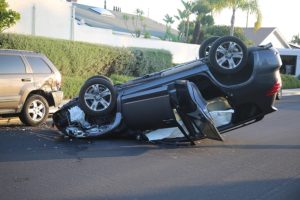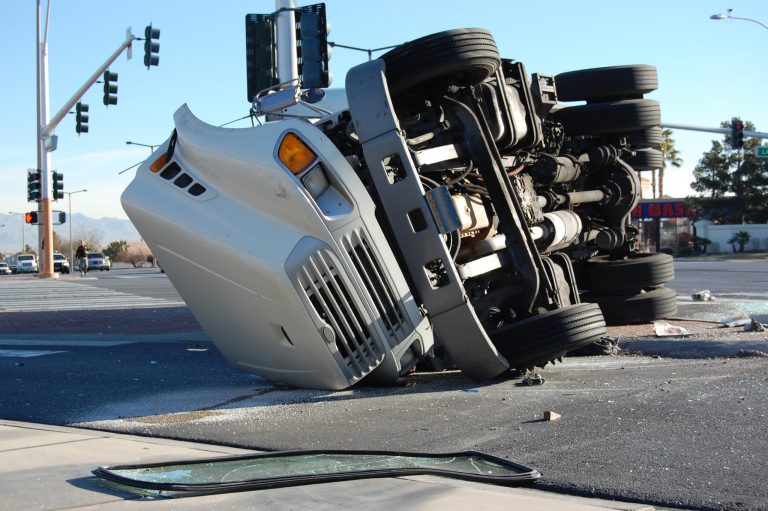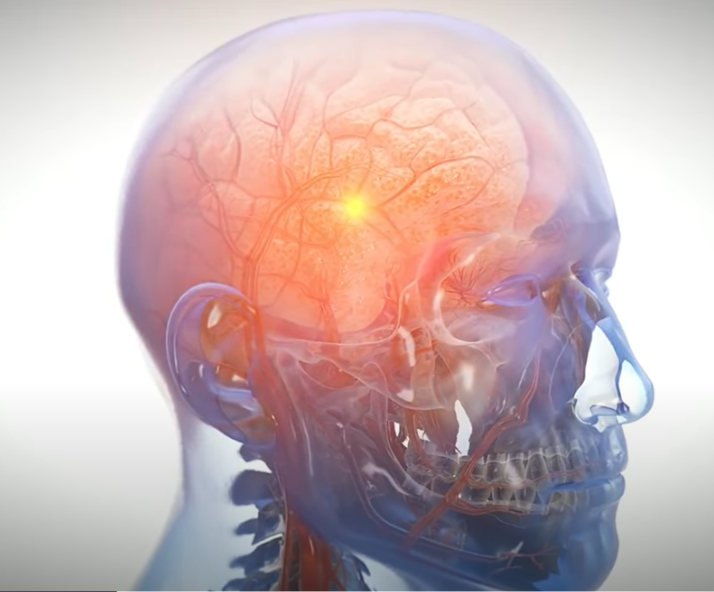 While all motor vehicle accidents have a propensity for danger, one of the most dangerous types of accidents to experience is one where the vehicle you’re riding in rolls over. Rollover accidents are both dangerous and tragically common. If you’ve sustained injuries in a rollover accident, read on for more information.
While all motor vehicle accidents have a propensity for danger, one of the most dangerous types of accidents to experience is one where the vehicle you’re riding in rolls over. Rollover accidents are both dangerous and tragically common. If you’ve sustained injuries in a rollover accident, read on for more information.
Rollover Statistics
According to data from the National Highway Traffic Safety Administration (NHTSA), only around 2 percent of all traffic accidents involve a vehicle rolling over. However, rollovers account for nearly 35 percent of all deaths in accidents involving passenger vehicles. Read on for more information about this often deadly type of accident, the injuries it produces, how you can avoid a rollover, and what to do if you sustain an injury in a rollover accident.
Why Rollover Accidents Are so Dangerous
When a rollover occurs, the force of the vehicle’s rotation is often absorbed by the bodies inside, resulting in serious injuries, even if the vehicle’s occupants are wearing their seat belts. Along with the rollover’s force, the vehicle’s occupants also risk serious injury from the roof collapsing or from personal contents inside the vehicle that may fly around the vehicle’s cabin at a high rate of speed.
Those who fail to wear their seat belts and experience this type of crash are generally ejected from the vehicle and may sustain severe injuries due to their bodies colliding with the ground or other objects.
In addition to overrepresentation in fatal crash statistics, rollover accidents also produce some of the most severe types of injuries that one can incur, including:
- Traumatic brain injuries: Motor vehicle crashes often result in this type of injury. The brain is responsible for controlling the body’s functions and involuntary responses, but has only a limited ability to heal after an injury. This often results in deficits that create permanent disability.
- Spinal cord injuries: Contrary to popular belief, a spinal cord injury rarely produces a severed cord but rather a cord that is damaged but intact. The spinal cord is a bundle of nerves extending from the base of the skull to below the waist that sends impulses from the brain to various parts of the body. Individuals suffering spinal cord injuries usually experience a loss of sensation and function below the injury site, or paralysis. Paralysis often results in permanent disability.
- Internal injuries: Penetrating objects, broken bones, or even the force of the accident itself can cause damage to internal organs that can cause dangerous or even deadly internal bleeding.
Types of Rollover Accidents
There are two types of rollover accidents, tripped and untripped:
- The vast majority of rollovers are tripped, meaning the vehicle’s tires struck something, such as a median, that caused the vehicle’s weight to shift sideways while the vehicle continues moving forward. This rolls the vehicle over.
- Untripped rollovers are far less common and generally involve a vehicle with a high center of gravity rolling over while going around a corner or curve at speed or while attempting to avoid a collision.
Common Causes of Rollover Accidents
Several conditions can increase the likelihood of experiencing a rollover accident, such as:
- Vehicle type. While rollover accidents are possible in any vehicle, they are more common in vehicles with higher centers of gravity, such as commercial trucks, pickup trucks, or SUVs.
- Speed. Excessive speed is an established contributor to rollover accidents, as vehicles are harder to maneuver when moving quickly. Three-quarters of rollover accidents take place on roadways where the posted limit is 55 miles per hour or more.
- Alcohol impairment. Around half of all fatal rollover crashes involve an alcohol-impaired driver. Alcohol impairment deteriorates the skills needed for safe driving such as the ability to maintain one’s own travel lane, to accelerate or brake effectively, or to exercise good judgment.
- Location. Rural roads that do not have a center divider between opposing travel lanes and a higher posted speed limit are the most common areas for rollover accidents to occur.
- Routine driving. Driving the same route every day lends itself to risky driving behaviors such as speeding or distracted driving. Up to 90 percent of the drivers involved in fatal, single-car rollovers were completing routine driving maneuvers when the accident occurred.
- Single-vehicle crashes. Single-vehicle crashes occur when a motor vehicle strikes a stationary object such as a parked car or a median, or even a moving object such as a bicyclist or pedestrian. The majority of fatal rollover crashes involve a single vehicle.
- Multi-car accidents. Although single-vehicle crashes account for most rollovers, a rollover can be part of a multi-vehicle crash as well, with one vehicle actually serving as the “trip” for another vehicle in the accident.
Preventing and Surviving a Rollover Accident
While not all accidents are preventable, there are several things that you can do to avoid becoming injured or even dying in a vehicle rollover.
Some tips include:
- When car-shopping, remember that newer really is better. The rollover driver death rate in SUVs, for example, has decreased significantly in newer models as these vehicles are often equipped with the newest safety features.
- Always wear your seat belt. Wearing a seatbelt has an estimated savings of nearly 15,000 lives a year and more than 90 percent of vehicle occupants now buckle up when they hit the road. Nearly half of all individuals killed in motor vehicle crashes did not buckle up at the time of the accident.
- Inflate your tires according to the manufacturer’s instructions. Tires that are over or under-inflated are a major cause of vehicle rollovers.
- Do not overload your vehicle. Overloaded or improperly loaded vehicles—particularly those with higher ground clearance, such as trucks and SUVs—experience a decrease in stability, particularly around curves or corners, or if the load shifts and further creates a weight imbalance on the vehicle.
- Drive at a safe speed for the conditions of the road. Approximately 40 percent of all rollover accidents involve excessive speed. Speeding makes it harder to control your vehicle and reduces the amount of time you need to respond appropriately to hazardous driving conditions.
- Use extra caution on rural roads. The majority of rollover accidents occur on rural roads that often do not have a median or divider between opposing traffic lanes.
If You Have Sustained Injuries in a Rollover Accident
If you sustained injuries in a rollover accident because of someone else’s careless or reckless actions, you can pursue compensation for the out-of-pocket expenses and quality-of-life impacts that you incurred. You would do this by filing a car accident lawsuit in civil court, generally within two years of the date on which the accident occurred.
Potentially Liable Parties
As rollover accidents are often single-vehicle crashes in which only the driver and his or her occupants are at risk of injury, often the injured party is also the liable party.
However, even in single-car accidents, there are other sources of liability besides the driver, such as:
- The manufacturer or distributor of your vehicle or vehicle parts that were defective and factored into the accident or caused the accident to be more severe;
- The governmental agency tasked with building and maintaining the roadway if a roadway defect caused your vehicle to roll over; or
- The driver of another vehicle, whose actions caused you to swerve to avoid an accident.
How to Prove Liability in Your Rollover Accident
The word liability refers to the legal responsibility for the physical harm caused by the accident.
Proving liability is one of the main points of your legal claim and involves establishing the following elements in your case:
- The at-fault party owed you a duty of care. The duty of care refers to the actions that a reasonable person would have taken in similar circumstances.
- There was a breach in the duty of care owed to you. This means that the at-fault party’s action(s) did not meet the reasonable person standard.
- This breach caused the incident resulting in your injuries as well as the expenses and impacts you incurred from your injuries.
The Damages You Can Recover After Your Rollover Accident
California law allows accident victims to pursue recovery of both economic and non-economic damages. The word damage in the legal arena refers to a payment made in compensation for harm. Economic damages refer to a payment made in compensation for the financial harm you incurred because of your injury.
Common economic damages plaintiffs include in a claim are:
- Medical expenses, including the cost of emergency treatment at the scene of the accident or in the emergency department, transport to the hospital by ambulance or air, hospitalization, diagnostic testing, physician and surgical services, prescription medication, physical therapy, and rehabilitation. You can also include the expense of assistive devices such as a wheelchair or crutches, and modifications to your home that are necessary to accommodate the injury, such as lowered cabinets, automatic doors, and roll-in showers.
- Lost wages from injuries that prevent you from working or cause you to miss missing work to attend injury-related medical appointments.
- Loss of future earning capacity if your injury results in a permanent disability that prevents you from working or from earning in the same capacity as you did before the incident.
Non-economic damages attempt to compensate you for the impact your injury has on your quality of life.
Common non-economic damages plaintiffs include in a claim are:
- Physical pain and suffering
- Emotional distress
- Loss of the enjoyment of life
How an Attorney Can Help
Rollover accidents are often complex, requiring legal expertise to identify all sources of liability involved. An experienced car accident attorney on your case provides you the legal expertise necessary to fight for the maximum amount of compensation you may receive. You also get an individual with a firm understanding of the expenses and impacts car accident victims commonly face.
While individuals may feel tempted to avoid the expense of an attorney, you can rest assured that you will receive the services you need regardless of your financial status through two very important offerings:
- A free case review: This is a time for you to share details of your case with an attorney, obtain answers to the legal questions you have about your case, and learn more about the law firm’s success in handling cases like yours.
- Contingent-fee payments: Contingent fee means that you do not have to pay for your lawyer’s services until there is a successful outcome to your case. In other words, the attorneys take a percentage of any recovery of your case.
Other important services your experienced car accident attorney can provide include:
- A value of your case that is based on the expenses and impacts you have incurred as a result of your injury as well as the future expenses and impacts you will likely face.
- Skilled negotiation with the at-fault party’s insurance provider in an attempt to obtain a fair settlement offer on your behalf.
- The timely filing of all court-required paperwork in the proper jurisdiction and attendance at all pre-trial conferences or hearings on your behalf.
- Guidance as to the benefits and downsides of accepting an offered settlement.
- The collection and organization of evidence and witness testimony that can help prove your claims.
- Litigation, including delivering opening and closing arguments, presenting evidence, and examining witnesses.
- Assistance with collecting your settlement or award.

If you sustained injuries in a car rollover accident, contact an experienced car accident attorney to help with your case. To discuss the details of your accident and determine your eligibility to seek compensation, contact an attorney as soon as possible.
Gomez Trial Attorneys
655 West Broadway, Suite 1700
San Diego, Ca 92101
619-237-3490







